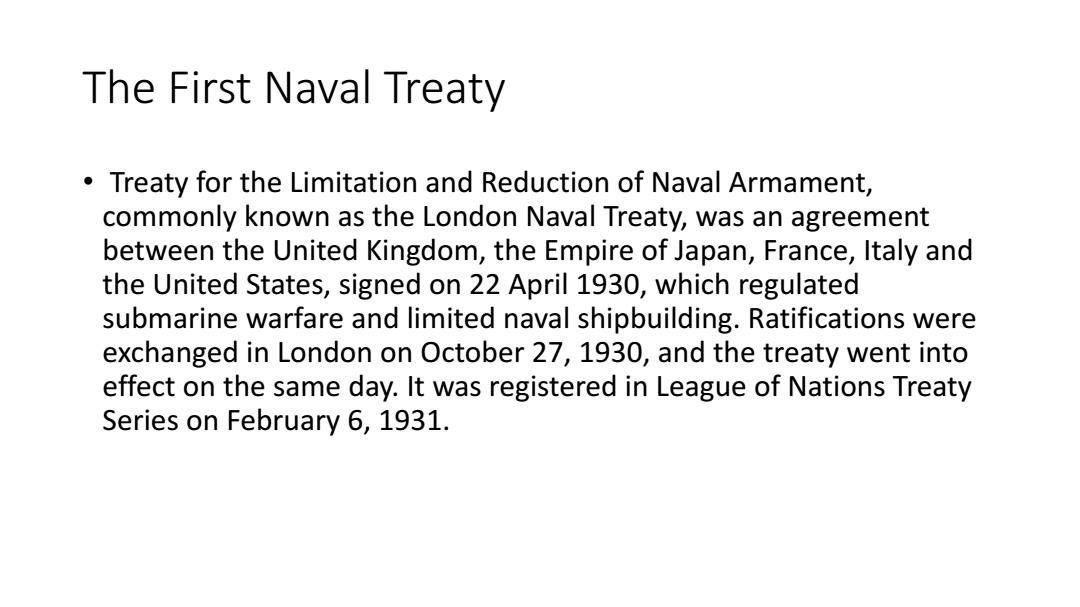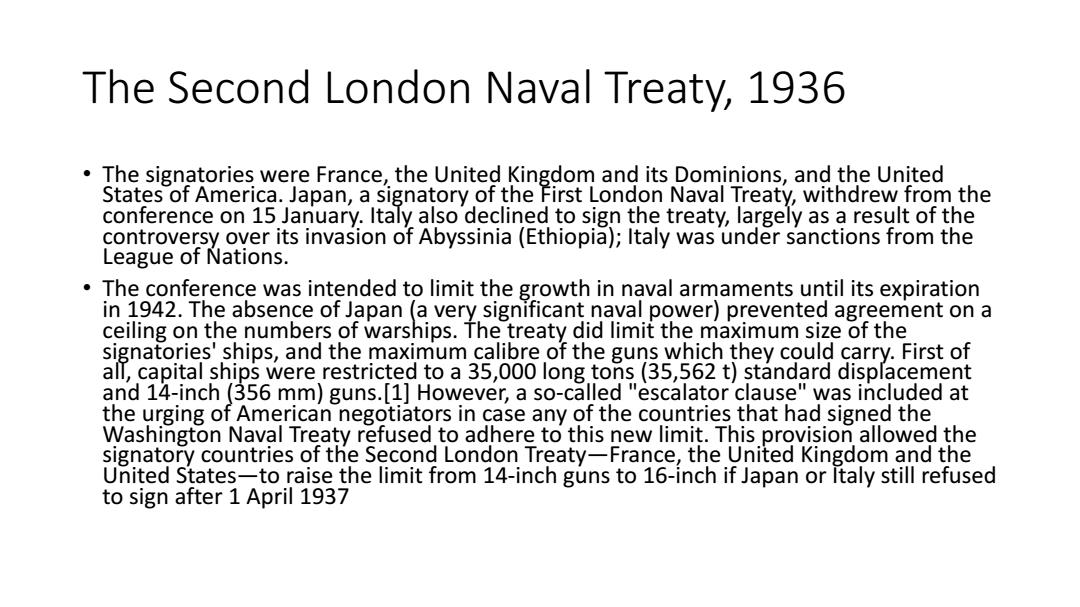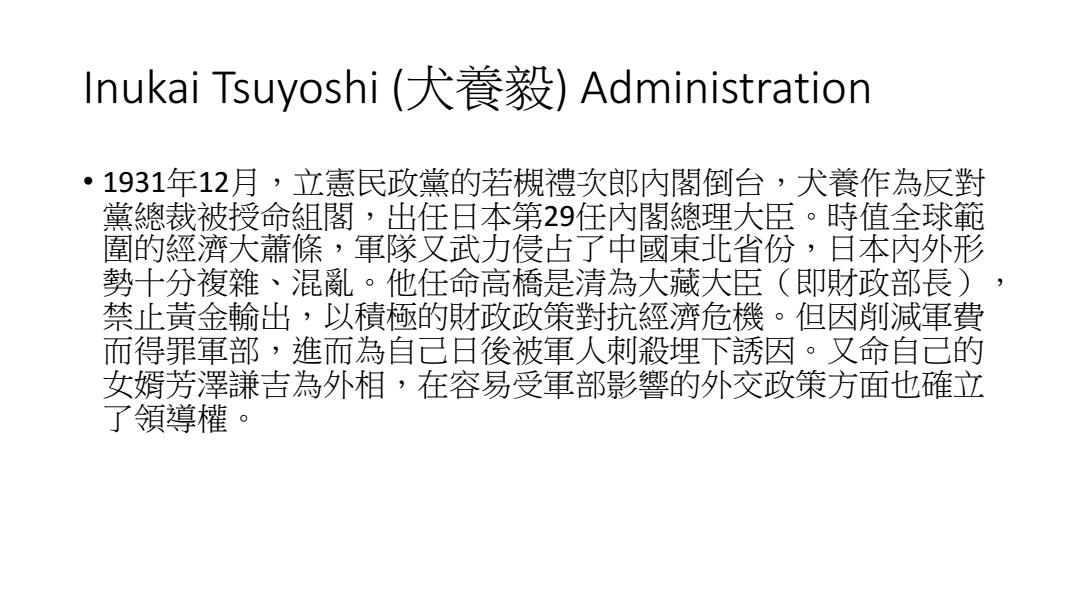
The First naval Treaty Treaty for the Limitation and Reduction of Naval Armament, commonly known as the London Naval Treaty,was an agreement between the United Kingdom,the Empire of Japan,France,Italy and the United States,signed on 22 April 1930,which regulated submarine warfare and limited naval shipbuilding.Ratifications were exchanged in London on October 27,1930,and the treaty went into effect on the same day.It was registered in League of Nations Treaty Series on February 6,1931
The First Naval Treaty • Treaty for the Limitation and Reduction of Naval Armament, commonly known as the London Naval Treaty, was an agreement between the United Kingdom, the Empire of Japan, France, Italy and the United States, signed on 22 April 1930, which regulated submarine warfare and limited naval shipbuilding. Ratifications were exchanged in London on October 27, 1930, and the treaty went into effect on the same day. It was registered in League of Nations Treaty Series on February 6, 1931

The Second London Naval Treaty,1936 The signatories were France,the United Kingdom and its Dominions,and the United States of America.Japan,a signatory of the First London Naval Treaty,withdrew from the conference on 15 January.Italy also declined to sign the treaty,largely as a result of the controversy over its invasion of Abyssinia(Ethiopia);Italy was under sanctions from the League of Nations. The conference was intended to limit the growth in naval armaments until its expiration in 1942.The absence of Japan(a very significant naval power)prevented agreement on a ceiling on the numbers of warships.The treaty did limit the maximum size of the signatories'ships,and the maximum calibre of the guns which they could carry.First of all,capital ships were restricted to a 35,000 long tons(35,562 t)standard displacement and 14-inch (356 mm)guns.[1]However,a so-called "escalator clause"was included at the urging of American negotiators in case any of the countries that had signed the Washington Naval Treaty refused to adhere to this new limit.This provision allowed the signatory countries of the Second London Treaty-France,the United Kingdom and the United States-to raise the limit from 14-inch guns to 16-inch if Japan or Italy still refused to sign after 1 April 1937
The Second London Naval Treaty, 1936 • The signatories were France, the United Kingdom and its Dominions, and the United States of America. Japan, a signatory of the First London Naval Treaty, withdrew from the conference on 15 January. Italy also declined to sign the treaty, largely as a result of the controversy over its invasion of Abyssinia (Ethiopia); Italy was under sanctions from the League of Nations. • The conference was intended to limit the growth in naval armaments until its expiration in 1942. The absence of Japan (a very significant naval power) prevented agreement on a ceiling on the numbers of warships. The treaty did limit the maximum size of the signatories' ships, and the maximum calibre of the guns which they could carry. First of all, capital ships were restricted to a 35,000 long tons (35,562 t) standard displacement and 14-inch (356 mm) guns.[1] However, a so-called "escalator clause" was included at the urging of American negotiators in case any of the countries that had signed the Washington Naval Treaty refused to adhere to this new limit. This provision allowed the signatory countries of the Second London Treaty—France, the United Kingdom and the United States—to raise the limit from 14-inch guns to 16-inch if Japan or Italy still refused to sign after 1 April 1937

Inukai Tsuyoshi(犬養毅)Administration ·1931年12月,立憲民政黨的若覜禮次郎内閣倒台,犬養作為反對 黨總裁被授命組閣,出任日本第29任內閣總理大臣。時值全球範 圍的經濟大蕭條,軍隊又武力侵占了中國東北省份,日本内外形 勢十分複雜、混亂。他任命高橋是清為大藏大臣(即財政部長), 禁止黄金輸出,以積極的財政政策對抗經濟危機。但因削减軍費 而得罪軍部,進而為自己日後被軍人刺殺埋下誘因。又命自己的 女婿芳澤謙吉為外相,在容易受軍部影響的外交政策方面也確立 了領導權
Inukai Tsuyoshi (犬養毅) Administration • 1931年12月,立憲民政黨的若槻禮次郎內閣倒台,犬養作為反對 黨總裁被授命組閣,出任日本第29任內閣總理大臣。時值全球範 圍的經濟大蕭條,軍隊又武力侵占了中國東北省份,日本內外形 勢十分複雜、混亂。他任命高橋是清為大藏大臣(即財政部長), 禁止黃金輸出,以積極的財政政策對抗經濟危機。但因削減軍費 而得罪軍部,進而為自己日後被軍人刺殺埋下誘因。又命自己的 女婿芳澤謙吉為外相,在容易受軍部影響的外交政策方面也確立 了領導權